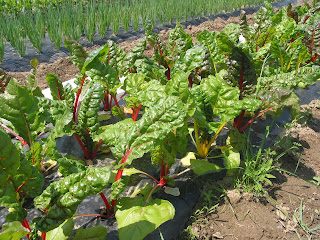We have several friends that have or have had a house rabbit. The kind that live in the living room and for which you pick up all the raisins it has left behind at the end of the day. We, of course, have dogs, but I've come to like another inhabitant of our home, the house spider.
Meet Charlotte
aka the common house spider, Achaearanea tepidariorum
 click on the photo to get a slightly better look at Charlotte
click on the photo to get a slightly better look at CharlotteCharlotte lives outside my home office window. She is a "cobweb" spider. You can't see it in the photo (I know, you can barely see Charlotte), but she has an irregular tangle of web that extends from the window glass to the side sash. A few small flying insects are tangled in the outer reaches. Think about the inside of your brain on a Friday afternoon (right about now) full of cobwebs, and there you have Charlotte's web!
Charlotte has a nice round abdomen that is grayish with light and dark speckles. Her head and thorax, collectively called the cephalothorax, is orange-colored. If you were up close you could see her narrow waist and her eight legs, both features that make her a spider.
At this very moment she is spinning some silk
by reaching her two hind legs
to her spinnerets at the back of her abdomen.
She is secreting a liquid through the spinnerets,
that hardens on contact with air,
as she pulls it to her two pairs of center legs,
which are holding a white ball of silk
that is getting bigger by the minute.
I think she is making an egg sac!
Charlotte probably has some relatives living in our basement and in the garage. When I vacuum down there (admittedly it is not often) I try to leave them be. When they start to take over the ceiling with their ever expanding webs, I admit to scooping some up in the vac.
There are thousands of spider species, most are harmless and beneficial eating flies, crickets, mites, and such. I am interrupted by Charlotte......
Charlotte is now extruding a yellowish-brown goo
from her abdomen into the partially formed silk wrap.
Some goo dripped and is stuck to the window pane.
I think those are eggs!
She's gone back to making silk,
continuing the silk wrap around the brown log-shaped sac.
Okay, back to spiders in general, as Charlotte continues her silk making. Spiders hunt in different ways. Some build webs to ensnare their prey. These can be cobwebby webs, or orb weaver webs (the circular, flat, elaborate webs that you see in meadows), or funnel webs. Some spiders are active hunters and some lay in wait. To identify spiders to just the proper family one usually needs a microscope to look at the arrangement of eyes (spiders have 6-8), thin sensory hairs, spines, and claws.
Our childhood stories and rhymes are full of spiders....."Little Miss Muffet sat on a tuffet, eating her curds and whey......" The spider scares Miss Muffet away so that is not the best for getting kids to like spiders. How about "The itsy bitsy spider climbed up the water spout, down came the rain and washed the spider out, out came the sun, and dried up all the rain, and the itsy bitsy spider went up the spout again." And then there is Charlotte, friend of Wilbur, the pig.
My Charlotte continues to wrap the sac with silk.
It is an odd pear-shaped sac.
I must tear myself away now and fix dinner.
I'll check in with Charlotte in the morning,
and let you know her progress.
Be not frightened of these amazing creatures.
 The garter snake is variable in color and attitude, sometimes being fairly docile and other times more aggressive if handled. This garter snake let us get close, without much reaction. I think the snake was just happy that the sun was shining.
The garter snake is variable in color and attitude, sometimes being fairly docile and other times more aggressive if handled. This garter snake let us get close, without much reaction. I think the snake was just happy that the sun was shining. These pictures were taken at Winterberry Farm in Western Massachusetts last week. Now that I am back in coastal New Hampshire, the rain continues. I think we are up to 8+ inches for the month of June, 3x times the average.
These pictures were taken at Winterberry Farm in Western Massachusetts last week. Now that I am back in coastal New Hampshire, the rain continues. I think we are up to 8+ inches for the month of June, 3x times the average. The common garter snake (Thamnophis sirtalis) typically is blackish with three light yellow stripes on its back or dorsum -- one down the center and one along each side. The females give birth to 14-40 live young (being "viviparous") between July and September. Many of our snakes are viviparous, but some such as the racer, smooth green snake, and milk snake lay eggs.
The common garter snake (Thamnophis sirtalis) typically is blackish with three light yellow stripes on its back or dorsum -- one down the center and one along each side. The females give birth to 14-40 live young (being "viviparous") between July and September. Many of our snakes are viviparous, but some such as the racer, smooth green snake, and milk snake lay eggs.









































